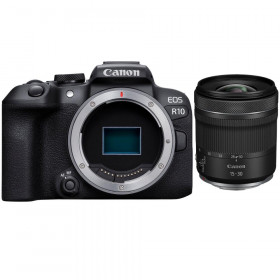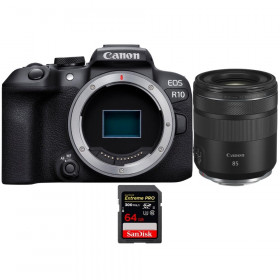
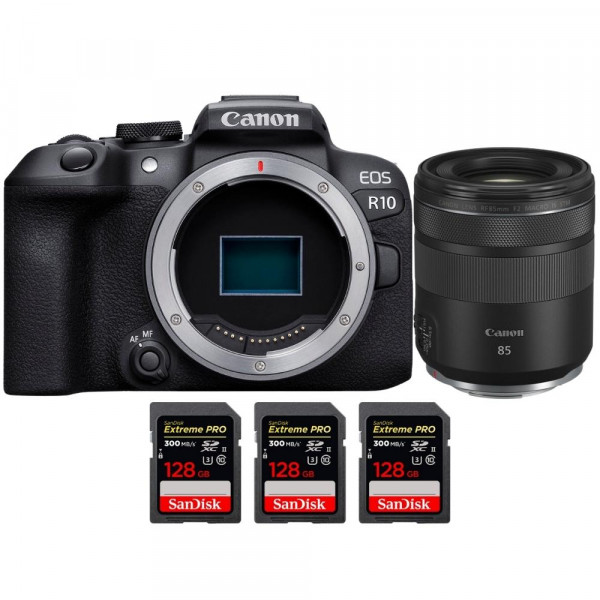
Canon EOS R10 + RF 85mm F2 Macro IS STM + 3 SanDisk 128GB Extreme PRO UHS-II SDXC 300 MB/s

The Canon EOS R10 mirrorless camera is a great all-around choice with a 24.2-megapixel APS-C sensor, 4K/30p upsampled video, automatic subject detection, and a RAW burst mode up to 30 frames per second for AF tracking.
FREE SHIPPING
Tracked and secured within 6/15 days
FINAL PRICE
Nothing to pay on delivery
100% BRAND NEW
3 years warranty
EASY RETURNS
Returns possible for 14 days
The Canon EOS R10 is a mirrorless camera with an APS-C sensor. It is the successor of the Canon EOS 90D SLR. It is the successor to the Canon EOS 90D, and it has a smaller and more balanced spec sheet than its predecessors.
The EOS R10, which is the lightest of all Canon's APS-C mirrorless, claims to be the company's lightest body of any mount (except EOS M). It allows itself to be 20 grams lighter than the "small" Canon EOS 250D SLR, which weighs 429 grams. It measures 12.3 cm wide by 8.7 cm wide and is particularly tiny, fitting naturally into any camera bag.
In terms of positioning, it is primarily aimed at experienced amateurs, both in photography and video. In fact, it follows the continuity of Canon SLRs with a total number of more than 2 digits. It is said to be consistent with the EOS 90D, which was introduced in 2019 by Canon.
So it is not a model for beginners, which leaves the door open for a cheaper (and hypothetical) mirrorless in the future.
One of the first two APS-C mirrorless with an RF mount
The Canon EOS R10 is compatible with all full-frame mirrorless lenses (RF mount), with a crop factor of 1.6x (as with EF and EF-S mount SLRs).
When attached to the EOS R10, a 50mm lens provides an 80mm equivalent field of view.
However, the Canon EOS R7 is compatible with a wide range of EF and EF-S mount lenses via the EF-RF adapter ring.
Finally, the RF-S completes the evolution of the EOS family of lenses. They are compatible with Canon's full frame mirrorless (allowing de facto APS-C mode on the camera).
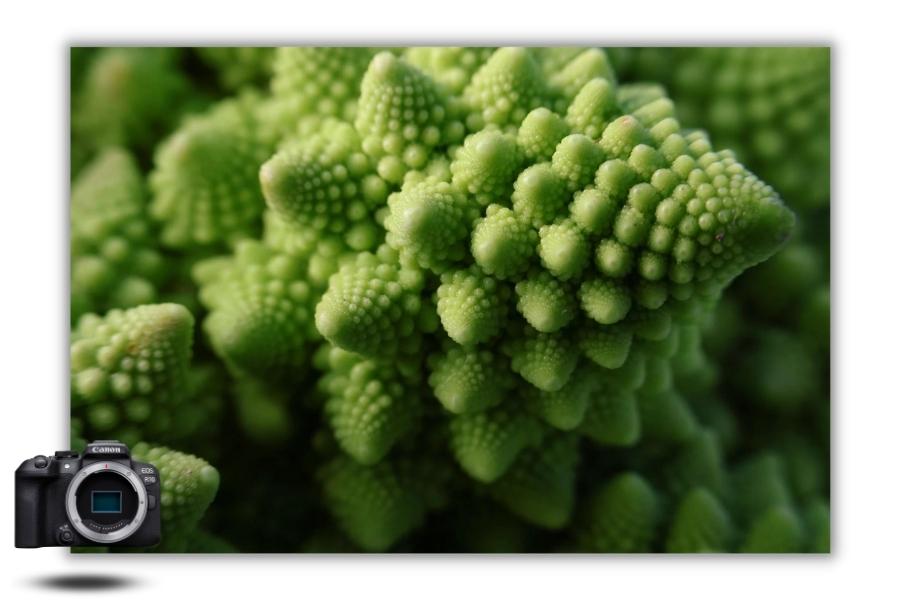
Excellent ergonomic design
The design of the Canon EOS R10 APSC mirrorless is similar to its predecessors. The body is ultra-compact, with rounded lines that make it easy to handle. Of course, the RF mount is visible here, as it has a diameter of 54 mm.
We appreciate the return of a traditional rear joystick, located under the thumb and integrated into the handlebar. The rotating screen, which is mounted on a swivel and can be adjusted for ground level or arm's length framing in photo or video, is also very useful. We appreciate that there is a "real" rear control, under the thumb.
Around the depth of field simulation button, you'll notice the arrival of a new focus switch (AF/MF). This means that Canon no longer needs to integrate it into its lenses.
Finally, we will discuss the new multi-function hot shoe (borrowed from the EOS R5C and Canon EOS R3), as well as a tiny pop-up flash. For the first time in an EOS R camera!

24.2 MP non-stabilized sensor
The sensor of the Canon EOS R10 is a 24.2MP APS-C sensor. It looks similar to the EOS 80D, but Canon promises that it has been upgraded with new micro lenses to improve image quality. The huge diameter of the RF mount makes the sensor look tiny.
The EOS R10's sensor is not stabilized, unlike the EOS R7. Obviously, if you shoot frequently in low light, the lack of sensor stabilization (IBIS) can be problematic (unlike the EOS R7).
The EOS R10's sensor is linked to the Digic X chip, which has already been used in other cameras (EOS R6, R5, R5C and R3). A sensitivity of ISO 100 to 32,000 (expandable to ISO 51,200) is available at the key.

Up to 23 frames per second in burst mode and dual pixel autofocus
The performance of the EOS R10 has not been reduced, even if the body has been simplified. For example, it benefits from Dual Pixel CMOS AF II, previously found on Canon cameras.
It also takes advantage of the new sophisticated autofocus modes, as on the EOS R7. The camera is able to identify a person's face and eye, as well as the face and eye of animals (dogs, cats and birds). It can also identify motorcycle helmets with ease.
The EOS R7 and R10 have the same level of autofocus... with one exception. Indeed, the AF sensitivity of the EOS R10 is slightly lower in low light (-4 EV versus -5 EV).
The Canon EOS R10 APSC mirrorless can shoot up to 15 frames per second with a mechanical shutter. It can also capture footage at a rate of 23 frames per second with the electronic shutter.
That's a bit slower than the EOS R7, which boasts a frame rate of 30 frames per second (and no blackout). Nevertheless, this performance is impressive and should make amateur sports photographers happy.
In terms of buffer memory, there are 460 JPEGs and 29 RAWs (mechanical shutter), as well as 70 JPEGs and 21 RAWs (electronic shutter). The speed of the bursts is undeniably amazing... but the bursts themselves won't last long.
Finally, keep in mind that the Canon EOS R10 can "only" do 1/4000s (mechanical shutter), while the EOS R7 can go up to 1/8000s. However, both cameras are capable of reaching speeds of at least 1/16000s.

4K 30p without crop
Canon has equipped its EOS R10 with the right video features to help photographers who want to (also) get into video. For example, the camera is capable of shooting 4K UHD video at 30 fps without cropping. The same can be said of a camera like the EOS RP!
The Canon R10 can capture footage in 4K 60P, which is fantastic for creating slow motion video. However, this comes at the cost of some image clipping (x1.56). Note that shooting in Full HD at 120 fps is also possible.
The HDR PQ image quality mode is also available. The camera can take pictures in JPEG and RAW formats.
Finally, you can record for up to 2 hours. This is ideal for recording interviews, for example. You'll have to upgrade to the EOS R7 if you want to record longer than that.
If the camera doesn't have sensor stabilization, it has a two-stage software stabilization effect. The cropping produced by the latter is designated by a specific percentage (10% or 30%). Canon is reassuring on this point, saying that many RF-S lenses will be stabilized.

A well-integrated connection
The Canon EOS R10 has only one SD card slot to save your photos. This is compatible with UHS-II cards, which is fortunate. Therefore, if you want a dual SD card slot, you'll have to look elsewhere.
The EOS R10 is pretty well equipped when it comes to connectivity. A USB Type C socket, which allows you to charge the camera's battery when it's turned off. It's a little cheat from Canon: instead of being a USB 3 port, it's a USB 2.0 port. To move your photos, you'll have to use the "traditional" approach and remove the SD card from the case yourself.
This model has an HDMI output (D-type) and a microphone jack (3.5mm jack), as well as an RS-60E3 remote control jack. However, it does not have a headphone jack.
As for wireless technology, the EOS R10 is equipped with Wi-Fi (2.4 GHz) and Bluetooth 4.2. Finally, Canon made an announcement about a future cloud-based RAW image processing feature, which should be available later this year.
The Canon LP-E17 battery was used for the EOS R10. If you already own a Canon EF-M mirrorless (EOS M3, M6 Mark II, or M50...) or a Canon APS-C SLR camera (EOS 77D, EOS 800D, etc.), you can reuse your battery stock without restriction. The same charger (LP-E17E) is also included in the box
In terms of control, Canon promises 430 JPEG shots with the LCD and 260 JPEG shots with the viewfinder. Values that are lower than those of the EOS R7... We will have to test it in the field to see if they are accurate.
Finally, we note that Canon does not plan to provide a grip with the EOS R10, well, for now.

What we like about the Canon EOS R10
- Ultra-lightweight APSC camera with hybrid capabilities, ideal for anyone considering a mirrorless system.
- 24.2-megapixel stills and stunning 4K/30p upsampled video as well as up to 120p slow motion in Full HD.
- The fast DIGIC X processor works with state-of-the-art Dual Pixel CMOS AF II with AI subject recognition.
- Shoot at amazingly fast frame rates, up to 15fps in mechanical shutter mode or 23fps with the electronic shutter.
- Attach a wide range of lenses, from full-frame RF mirrorless lenses to the new RF-S lenses and even EF DSLRs with an adapter.

Does the Canon EOS R10 have image stabilization?
One of the key features of the Canon R10 mirrorless camera is the lack of a sensor-based image stabilization system.
Instead, the R10 uses a unique lens-based stabilization system that is compatible with 21 existing Canon lenses.
This system allows the camera to take sharp photos and videos even in low light and shaky conditions.
As a result, the Canon EOS R10 is an excellent choice for photographers and videographers who need a reliable camera that can produce high-quality images and videos.

Is the Canon R10 weatherproof ?
The Canon EOS R10 is an APSC camera that was released in 2022. It has a 24.2-megapixel sensor and is capable of shooting 4K video.
One of its main features is its lack of environmental seals.
This means that the Canon apsc sensor camera is more susceptible to water and dust damage than other digital cameras on the market.
For this reason, it is important to be careful when using the Canon R10 and to protect it from the elements. There are a number of accessories that can help you do this, such as carrying cases and rain covers.
By taking a few simple precautions, you can ensure that your Canon R10 stays safe and dry, regardless of the weather.

What is the maximum ISO sensitivity of the camera Canon EOS R10?
The Canon R10 is a high-performance camera that offers excellent image quality and shooting capabilities.
It features a 24.0MP APS-C CMOS sensor and the latest Digic X processor. This gives it the ability to shoot at very high resolutions, up to 6000 x 4000 pixels.
Aspect ratios of 1:1, 4:3, 3:2 and 16:9 are all available, giving you plenty of options for your photos.
The native ISO range of 100-32,000 can be increased to 100-51200, giving you even more flexibility in low-light situations.
The EOS R10 also has the ability to save files in RAW format, giving you more post-processing options.
While not the highest resolution APS-C camera on the market, the Canon R10 is a very capable camera that should meet the needs of most photographers.
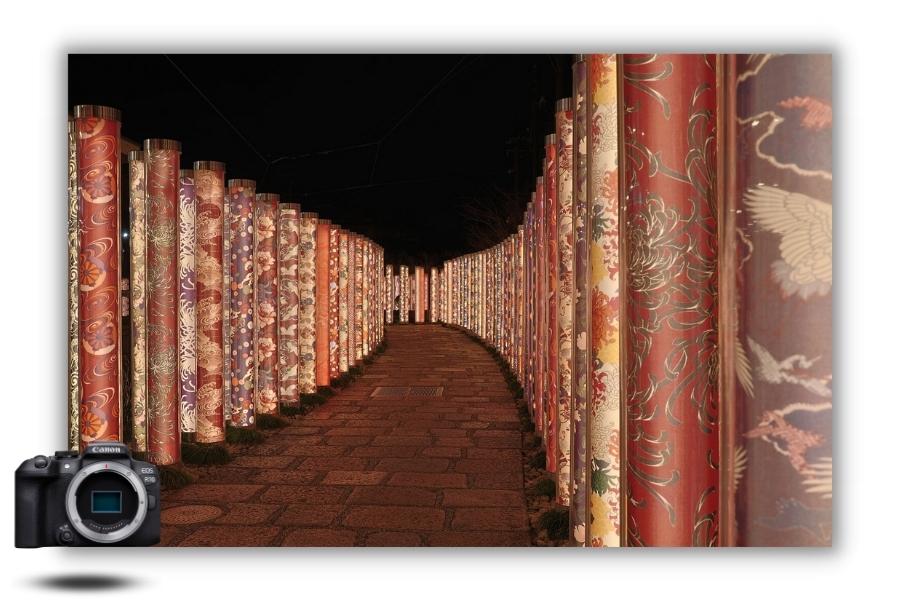
What is the maximum continuous shooting speed of the Canon R10?
The Canon EOS R10 has a maximum continuous shooting speed of 15.0 fps.
That's 5.9 fps faster than the average shooting speed of mirrorless cameras, making it ideal for sports photography or any other situation where the scene changes quickly.
With a maximum ISO sensitivity of 51200, it can also shoot in low-light conditions without sacrificing image quality.
In addition, the Canon EOS R10 features a variable angle LCD screen that makes it easy to take high-quality photos and videos from any angle.
As a result, the Canon EOS R10 is a versatile and powerful camera that is sure to meet the needs of the most demanding photographers.

What is the weight of the Canon EOS R10 APSC camera?
The Canon EOS R10 is a new addition to the company's line of mirrorless cameras.
Weighing in at 426g, it is slightly lighter than the average camera in its class.
The EOS R10 also has exterior dimensions of 122.5 x 87.8 x 83.4 mm, making it slightly thicker than the average camera.
However, this extra thickness does not seem to affect the overall performance of the camera.
In fact, the extra padding on the R10 may even help protect it from bumps and bruises.
Overall, the Canon R10 is a solid entry into the mirrorless camera market. Its weight and dimensions are about average, and the extra padding can help protect it.

Our opinion on the Canon EOS R10 hybrid APSC
Prior to the introduction of the Canon EOS R10, all previous mirrorless cameras were built around a full frame sensor. This substantial change allows photographers and video producers to carry much less equipment with smaller lenses that offer an even greater telephoto range than a full-frame camera.
The EOS R10 features state-of-the-art technology to help you get the shot you want or the movie scene you've been waiting for. Canon's sophisticated Dual Pixel CMOS AF II can track a variety of subjects, including people, animals and automobiles. This keeps subjects in focus no matter where they are in the frame at shooting rates of up to 15 frames per second in mechanical mode and 30 frames per second with sensor cropping, or 23 frames using the full sensor powered by the advanced DIGIC X processor.
With nearly unlimited lens alternatives, from APS-C format RF-S lenses to full-frame RF lenses and even DSLR lenses using a conversion adapter, you can create an unbeatable system for developing your expertise and producing stunning images, 4K movies, slow-motion content, panoramas and just about anything else.
Data sheet
- Sensor Resolution (Millions of pixels)
- 24.2 Megapixel
- Camera Format
- APS-C
- Memory card
- SD/SDHC/SDXC (UHS-II)
- Weight
- 429g
10 other products in the same category:

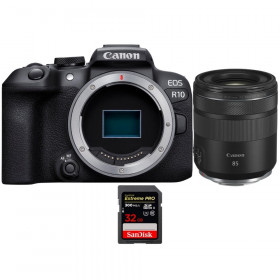
Canon EOS R10 + RF 85mm F2 Macro IS STM +...

Canon EOS R10 + RF-S 18-45mm F4.5-6.3 IS...

Canon EOS R10 + RF 24-105mm F4-7.1 IS STM...

Canon EOS R10 + RF 15-30mm F4.5-6.3 IS STM...
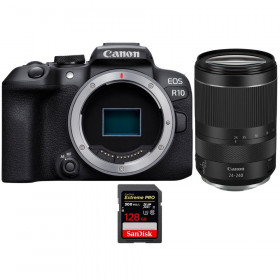
Canon EOS R10 + RF 24-240mm F4-6.3 IS USM...
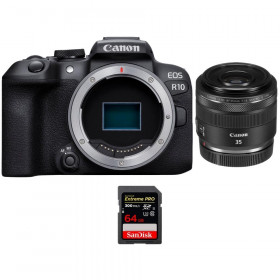
Canon EOS R10 + RF 35mm F1.8 IS Macro STM...

Canon EOS R10 + 3 SanDisk 128GB Extreme...

Canon EOS R10 + RF 85mm F2 Macro IS STM +...
